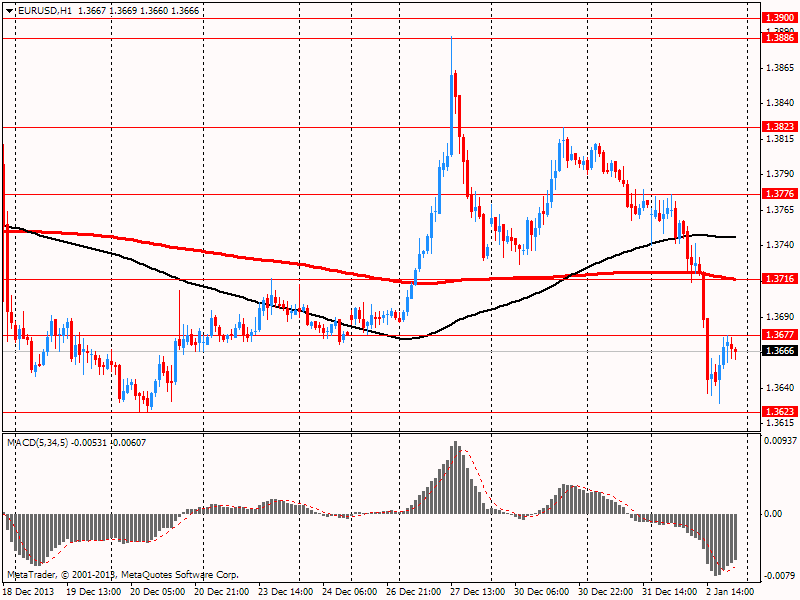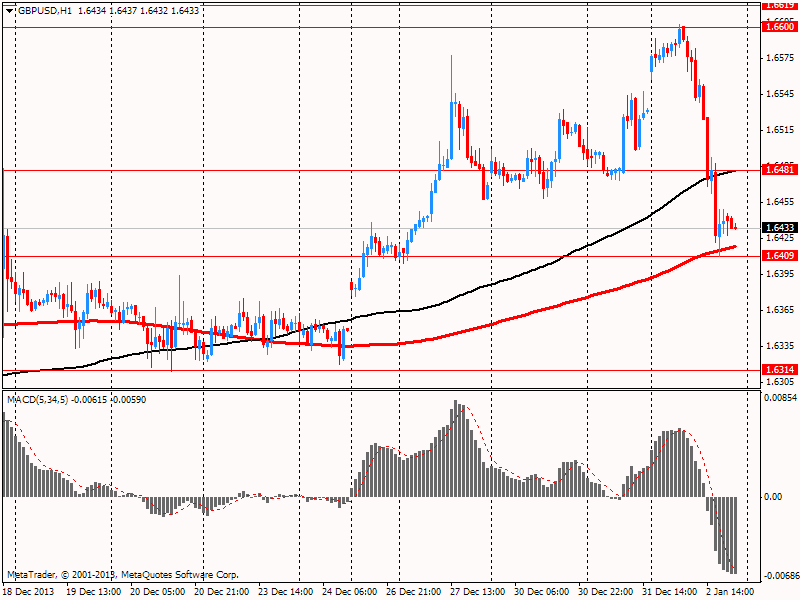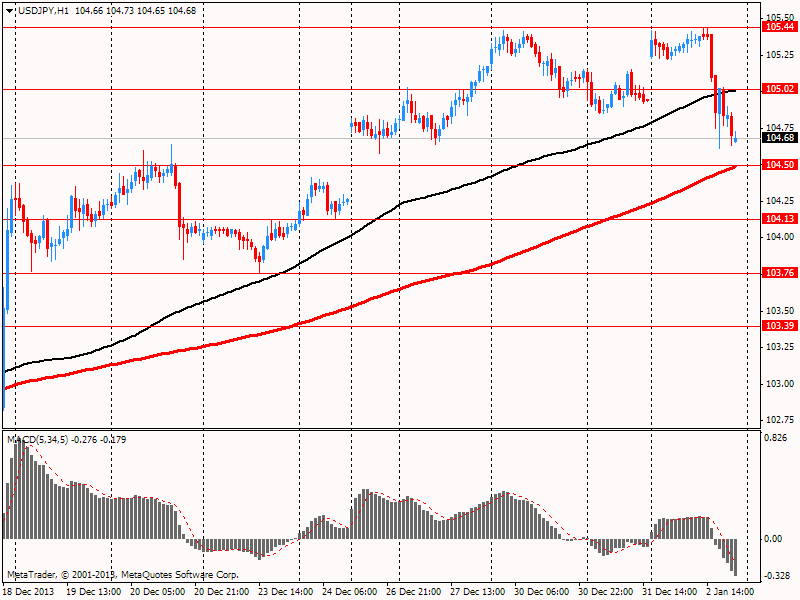Notícias do Mercado
-
20:00
Dow -128.6 16,448.06 -0.78% Nasdaq -37.52 4,139.07 -0.90% S&P -16.84 1,831.52 -0.91%
-
19:30
American focus : the euro has fallen markedly against the U.S. currency
Euro exchange rate dropped significantly against the dollar , despite the positive data on manufacturing activity in Germany and the euro area. Growth of the manufacturing sector lasted eurozone in December, according to preliminary estimates published last month, showed on Thursday the final results of a study Markit Economics. Purchasing Managers Index rose for the third month in a row to a level of 52.7 in December. Value was unchanged from the preliminary estimate was higher than November's 51.6 value .
In addition, the course of trade affected U.S. data . They showed that business conditions in the U.S. manufacturing sector improved at the fastest pace since January. Corresponding PMI rose to 55.0 in December compared with 54.7 in November and was higher than the preliminary estimate of 54.4 .
Meanwhile, another report published by the Institute for Supply Management (ISM), showed that in December manufacturing activity in the U.S. fell slightly less than economists' expectations . PMI index for the U.S. manufacturing declined this month to 57.0 vs. 57.3 in November. Note that the last reduction was weaker than economists' forecasts , which are expected to decline to 56.8 .
Not unimportant as were data on the number of applications for benefits . As it became known , the number of initial claims for unemployment benefits , a measure of layoffs, reduced by 2000 and totaled a seasonally adjusted 339,000 in the week ended December 28. Economists had expected 334,000 initial claims per week. The number of applications from the previous week was revised to 341,000 from 338,000 .
The British pound has fallen against the dollar , which was associated with the publication of the index of manufacturing activity , which came out weaker than expected . Recovery of production in the UK continued to the end of 2013 , data showed on Thursday surveys Markit Economics.
However, the purchasing managers' index from Markit / Chartered Institute of Purchasing & Supply fell to 57.3 in December from November's 33 -month high of 58.1 . Value in November was revised from 58.4 . A reading above 50 indicates an increase in activity.
The pace of expansion in output and new orders remained among the highest in the 22- year history of the survey. As a result, the pace of job growth were second in strength over the past two and a half years . On the price front, the average purchase and sale prices rose at a faster pace in December.
The yen has risen sharply against the U.S. dollar . Experts note that the main driver for the yen became the yield on U.S. assets , which reached multi-year highs above 3.0 % , with the pullback of U.S. stock indices .
In addition, the course of trade rumors affect the Bank of Japan will continue its unprecedented stimulus program , to support the economic strategy of Prime Minister Shinzo Abe . In general, the Japanese currency has fallen in the past year by 16% against a basket of nine other currencies. Hedge funds and other large speculators increased bets on a further fall in the yen against the dollar to a maximum value since July 2007.
-
18:15
European stock close
European stocks dropped, following their biggest annual advance since 2009, as utilities declined, while a report showed U.S. manufacturing slowed last month.
The Stoxx Europe 600 Index slipped 0.7 percent to 325.98 at 4:30 p.m. in London, their largest decline in two weeks. Global equities soared by $9.6 trillion in 2013 as central-bank bond buying helped the U.S. economy gain momentum, while the euro area emerged from recession.
In the U.S., the Institute for Supply Management’s manufacturing index slipped to 57 in December from 57.3 in November, which was its highest level in more than two years. Figures greater than 50 mean that activity expanded.
Final readings today confirmed that manufacturing in the euro zone expanded last month at the fastest pace since May 2011, while output in Germany, the currency bloc’s largest economy, expanded for a sixth consecutive month. French manufacturing contracted for a 22nd consecutive month.
National benchmark indexes fell in 12 of the 17 western-European markets that opened today.
FTSE 100 6,717.91 -31.18 -0.46% CAC 40 4,227.28 -68.67 -1.60% DAX 9,400.04 -152.12 -1.59%
RWE slipped 3.5 percent to 25.68 euros after Handelsblatt reported that the German utility will seek approval at its annual general meeting on April 16 to raise capital by as much as 10 percent. The newspaper cited unidentified people close to the company’s supervisory board. RWE spokesman Michael Murphy told Bloomberg News that the utility does not plan a capital increase for the forseeable future.
CGG lost 2.9 percent to 12.21 euros as UBS lowered its rating on the stock to neutral from buy and reduced its estimate for 2013 earnings before interest and taxes to $392 million from $504 million. UBS analyst Caroline Hickson said the company’s presentation to investors and analysts in December failed to reassure investors because of weaker-than-expected long-term targets and little guidance for 2014.
Fiat rallied 16 percent to 6.92 euros. The Italian carmaker said it will pay a United Auto Workers retiree health-care trust $1.75 billion in cash for the stake when the deal closes, which Fiat expects by Jan. 20. Chrysler will contribute $1.9 billion through a special dividend, as well as paying the trust $700 million in four annual installments, according to a statement.
Exor SpA, which owns a 30 percent stake in Fiat, advanced 4.5 percent to 30.20 euros, the shares’ biggest increase in almost six months.
Polymetal International Plc and Fresnillo Plc, which own silver and gold mines, added 1.7 percent to 584.5 pence and 1.3 percent to 755 pence, respectively. Both precious metals rebounded today after completing their worst year since 1981. Randgold Resources Ltd. gained 3.8 percent to 3,934 pence, following its largest annual decline since 1998.
-
17:00
European stock close: FTSE 100 6,717.91 -31.18 -0.46% CAC 40 4,227.28 -68.67 -1.60% DAX 9,400.04 -152.12 -1.59%
-
16:40
Oil: an overview of the market situation
Oil prices fell to their lowest level in more than two weeks (mark WTI), as improving U.S. economy has increased the likelihood that the Federal Reserve will further limit the quantitative stimulation. Futures fell 1.7 percent , registering the third consecutive session decline , after data showed that the number of applications for unemployment benefits in the U.S. fell . As it became known , the number of initial claims for unemployment benefits , a measure of layoffs, reduced by 2000 and totaled a seasonally adjusted 339,000 in the week ended December 28. Economists had expected 334,000 initial claims per week. The number of applications from the previous week was revised to 341,000 from 338,000 .
Recall that the Federal Reserve closely watching employment data to determine the right time to start reducing the amount of bond purchases designed to stimulate the economy.
The course of trade is also affected by expectations of future output inventory report . Experts estimate that U.S. crude stocks fell again , that may be the fifth consecutive weekly drop .
Meanwhile, add the data from the EIA, which will be released today , will probably show that gasoline inventories rose by 1.38 million barrels - up to 221.2 million during the week ending December 27. Distillate stocks are projected to increase by 750 thousand to 114.9 million
Cost February futures on U.S. light crude oil WTI (Light Sweet Crude Oil) fell to $ 96.49 a barrel on the New York Mercantile Exchange.
February futures price for North Sea Brent crude oil mixture fell $ 2.35 to $ 108.85 a barrel on the London exchange ICE Futures Europe.
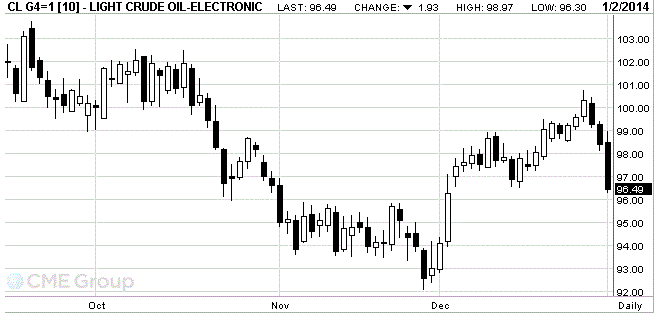
-
16:20
Gold: an overview of the market situation
Gold prices rose sharply today , which was associated with the resumption of physical purchases after prices fell to a six-month low . But many investors remained cautious because of the bright prospects for the world economy and speculation about the imminent end of quantitative easing in the U.S..
Recall that the price of the precious metal fell by 28 percent in 2013, while completing a series of 12 consecutive years of growth , as the U.S. Federal Reserve announced plans to change the ultrasoft monetary policy this month by lowering monthly asset purchases by 10 billion . dollars - up to 75 billion Quantitative easing helped gold to rise in recent years, maintaining pressure on long-term interest rates and stoking fears of inflation.
Analysts also say that the price movements are still due to low volumes during the holiday week .
" Liquidity remains very low , this should not rely too much on the economic data presented in an attempt to anticipate movement . Worth the wait until next week to have a clear picture of where we are located ," said Commerzbank analyst Daniel trademark Briesmann . " But while investments in exchange traded funds continue to decline , gold is likely to remain under pressure."
The data showed that the gold reserves in SPDR Gold Trust - the world's largest gold exchange-traded fund , remained unchanged on Tuesday - at the level of 798.22 thousand tons , which is the lowest level since January 2009 .
Meanwhile, add that influenced the course of trading data on unemployment in the United States. The number of people filing for first time applications for unemployment benefits fell slightly last week , while thousands of other Americans are faced with the loss of extended benefits.
The number of initial claims for unemployment benefits , a measure of layoffs, reduced by 2000 and totaled a seasonally adjusted 339,000 in the week ended Dec. 28 , said on Thursday the Ministry of Labour .
Economists had expected 334,000 initial claims per week. The number of applications from the previous week was revised to 341,000 from 338,000 .
Analyst Department of Labor said that there was nothing unusual in the data and that all states reported data for the Christmas week .
Cost February gold futures on the COMEX today dropped to $ 1223.10 per ounce.
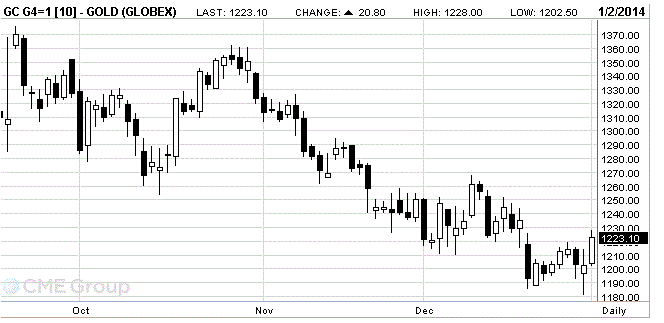
-
15:00
U.S.: Construction Spending, m/m, November +1.0% (forecast +0.7%)
-
15:00
U.S.: ISM Manufacturing, December 57.0 (forecast 56.8)
-
14:34
U.S. Stocks open: Dow 16,521.56 -55.10 -0.33%, Nasdaq 4,158.68 -17.91 -0.43%, S&P 1,842.06 -6.30 -0.34%
-
14:26
Before the bell: S&P futures -0.23%, Nasdaq futures -0.29%
U.S. stock-index futures declined, as investors awaited a report on manufacturing output.
Global markets:
Hang Seng 23,340.05 +33.66 +0.14%
Shanghai Composite 2,109.39 -6.59 -0.31%
FTSE 6,737.32 -11.77 -0.17%
CAC 4,262.49 -33.46 -0.78%
DAX 9,497.49 -54.67 -0.57%
Crude oil $97.08 (-1.36%).
Gold $1220.60 (+1.52%).
-
13:59
U.S.: Manufacturing PMI, December 55 (forecast 54.4)
-
13:46
Option expiries for today's 1400GMT cut
EUR/USD $1.3700
USD/JPY Y104.00
AUD/USD $0.8800, $0.8950, $0.9000
NZD/USD $0.8180, $0.8170, $0.8165, $0.8160
-
13:30
U.S.: Initial Jobless Claims, December 339 (forecast 334)
-
13:00
Orders
EUR/USD
Offers $1.3850/60, $1.3830, $1.3810-20, $1.3775/85, $1.3740/50
Bids $1.3700, $1.3650
AUD/USD
Offers $0.9000, $0.8985/90, $0.8958/60, $0.8953/55
Bids $0.8825/20, $0.8800
GBP/USD
Offers $1.6690/700, $1.6650, $1.6615/20, $1.6580/85
Bids $1.6500, $1.6485/75, $1.6450/45, $1.6410/00
EUR/GBP
Offers stg0.8467, stg0.8435/40, stg0.8415/20, Stg0.8400/05, stg0.8370/80
Bids stg0.8285/75, stg0.8260/50, stg0.8250, stg0.8220, stg0.8205/00
USD/JPY
Offers Y106.00, Y105.80, Y105.45/50
Bids Y105.25/20, Y105.10/00, Y104.50, Y104.20, Y104.00, Y103.80/75
EUR/JPY
Offers Y147.00, Y146.50, Y146.00, Y145.70/80, Y145.30/35
Bids Y144.45/35, Y144.20, Y144.00, Y143.85/80, Y143.60/50
-
11:31
European stocks declined
European stocks declined, following their biggest annual advance since 2009, as utilities dropped, while a measure of manufacturing in the euro zone matched economists’ estimates. Asian shares also retreated.
The Stoxx Europe 600 Index slipped 0.3 percent to 327.36 at 9:22 a.m. in London after earlier rising as much as 0.3 percent. The MSCI Asia Pacific excluding Japan Index declined 0.7 percent after the Chinese government’s manufacturing gauge showed output in the world’s second-biggest economy expanded in December at a slower pace than economists had forecast.
Global equities soared by $9.6 trillion in 2013 as central-bank bond buying helped the U.S. economy gain momentum, while the euro area emerged from recession. European stocks rallied 17 percent in 2013. Their biggest increase since 2009 sent the Stoxx Europe 600 Index to 15.4 times its constituents’ projected earnings, up from 12.7 times at the beginning of 2013.
Final readings today confirmed that manufacturing in the euro zone expanded last month at the fastest pace since May 2011, while output in Germany, the currency bloc’s largest economy, expanded for a sixth consecutive month. In the U.S., the Institute for Supply Management’s manufacturing index probably slipped in December from its highest level in more than two years, economists surveyed by Bloomberg projected. The ISM publishes the data at 10 a.m. New York time.
RWE AG slipped 1.7 percent after Handelsblatt reported that the German utility may ask shareholders to give it the option to raise capital.
CGG SA slipped 1.6 percent after UBS AG lowered its rating on the surveyor of oilfields.
Fiat SpA rallied the most in more than four years after the carmaker agreed to buy the remaining stake in Chrysler Group LLC, enabling the Italian and U.S. companies to merge.
FTSE 100 6,713.2 -35.89 -0.53%
CAC 40 4,245.99 -49.96 -1.16%
DAX 9,496.03 -56.13 -0.59%
-
10:23
Option expiries for today's 1400GMT cut
USD/JPY Y104.00
AUD/USD $0.8800, $0.8950, $0.9000
-
10:01
Asia Pacific stocks close
Asian stocks dropped, with a regional benchmark index retreating from a three-week high, after gauges of manufacturing in China declined, underscoring challenges for President Xi Jinping as he tries to sustain economic momentum while rolling out reforms.
Nikkei 225 Closed
Hang Seng 23,340.05 +33.66 +0.14%
S&P/ASX 200 5,367.91 +15.70 +0.29%
Shanghai Composit Closed
Industrial & Commercial Bank of China Ltd., the nation’s biggest lender, fell 1.3 percent in Hong Kong.
Hyundai Motor Co. and Kia Motors Corp. lost at least 5.1 percent after South Korea’s largest automakers forecast their weakest sales growth in eight years.
BHP Billiton Ltd., Rio Tinto Group and Fortescue Metals Group Ltd., Australia’s biggest iron-ore exporters, gained at least 0.6 percent as shipments from the world’s No. 1 exporter of the commodity resumed after a cyclone.
-
09:28
United Kingdom: Purchasing Manager Index Manufacturing , December 57.3 (forecast 58.3)
-
09:13
FTSE 100 6,724.86 -24.23 -0.36%, CAC 40 4,279.6 -16.35 -0.38%, DAX 9,542 -10.16 -0.11%
-
08:58
Eurozone: Manufacturing PMI, December 52.7 (forecast 52.7)
-
08:55
Germany: Manufacturing PMI, December 54.3 (forecast 54.2)
-
08:48
France: Manufacturing PMI, December 47.0 (forecast 47.1)
-
07:04
Asian session: The yen remained lower
00:00 China Bank holiday
00:00 Japan Bank holiday
01:45 China HSBC Manufacturing PMI (Finally) December 50.5 50.5 50.5
05:30 Australia RBA Commodity prices, y/y December -1.9% -4.0%
The yen remained lower after its biggest annual decline since 1979 amid prospects the Bank of Japan will continue unprecedented stimulus measures to support the economy and end more than a decade of deflation.
Japan’s currency extended losses as BOJ Governor Haruhiko Kuroda said, in an interview published yesterday in Yomiuri newspaper, that policy makers will continue stimulus until inflation stabilizes at 2 percent. Kuroda said achieving 2 percent inflation in two years is the BOJ’s goal, according to the Yomiuri article. The central bank won’t necessarily end or scale back its stimulus program in two years, he said, according to the interview. Monetary policy in Japan is diverging from the U.S., where the Federal Reserve is expected to end bond purchases this year.
The euro held an annual gain against the dollar before a report today that economists estimate will show a gauge of factory output in the common-currency region climbed to a 31-month high in December. That would confirm the initial reading published by Markit on Dec. 16.
The Australian dollar earlier traded lower from its year-end close after a gauge of Chinese manufacturing by HSBC Holdings Plc and Markit Economics fell to 50.5 last month from 50.8 in November, indicating slower expansion. Government figures released yesterday showed a separate index for factory output fell for the first time in six months to match an August reading of 51.
EUR / USD: during the Asian session, the pair traded in the range of $ 1.3740-70
GBP / USD: during the Asian session, the pair rose to $ 1.6600
USD / JPY: during the Asian session, the pair rose to Y105.40
Focus today will be on EZ mfg PMI releases (starting with Spain at 0813GMT), with the UK release coming at 0928GMT. US weekly jobless claims to follow at 1330GMT along with US PMI and ISM at 1358GMT/1500GMT respectively.
-
06:00
Schedule for today, Thursday, Jan 2’2013:
00:00 China Bank holiday
00:00 Japan Bank holiday
01:45 China HSBC Manufacturing PMI (Finally) December 50.5 50.5
05:30 Australia RBA Commodity prices, y/y December -1.9%
06:00 Switzerland Bank holiday
08:48 France Manufacturing PMI (Finally) December 47.1 47.1
08:53 Germany Manufacturing PMI (Finally) December 54.2 54.2
08:58 Eurozone Manufacturing PMI (Finally) December 52.7 52.7
09:30 United Kingdom Purchasing Manager Index Manufacturing December 58.4 58.3
13:30 U.S. Initial Jobless Claims December 338 334
14:00 U.S. Manufacturing PMI (Finally) December 54.4 54.4
15:00 U.S. Construction Spending, m/m November +0.8% +0.7%
15:00 U.S. ISM Manufacturing December 57.3 56.8
21:30 U.S. API Crude Oil Inventories December +0.5
-
05:35
Australia: RBA Commodity prices, y/y, December -4.0%
-
